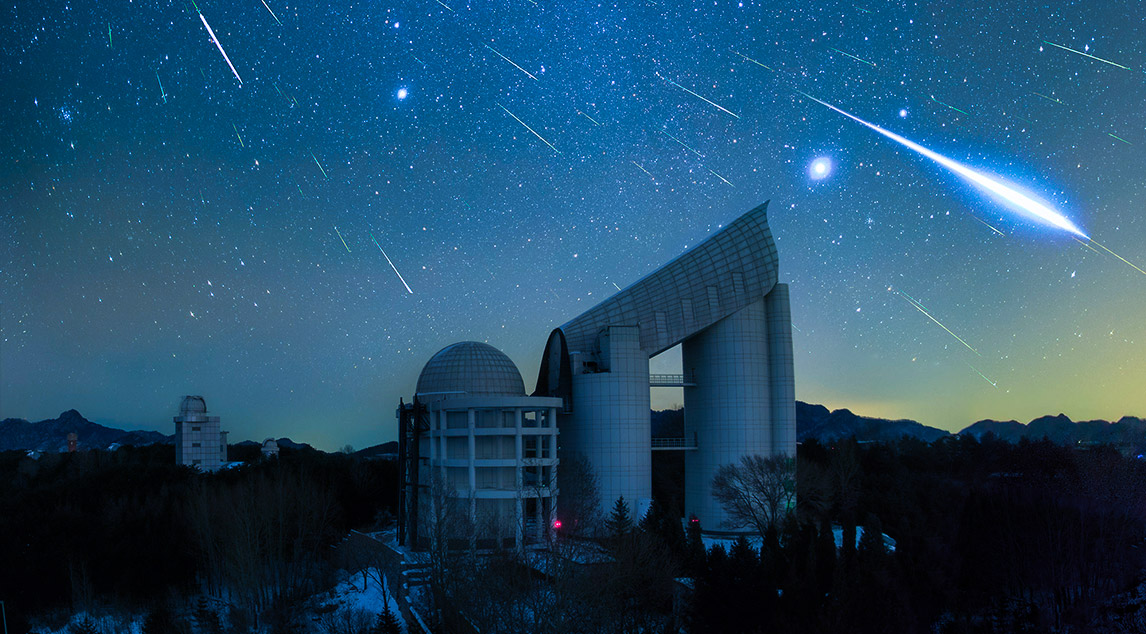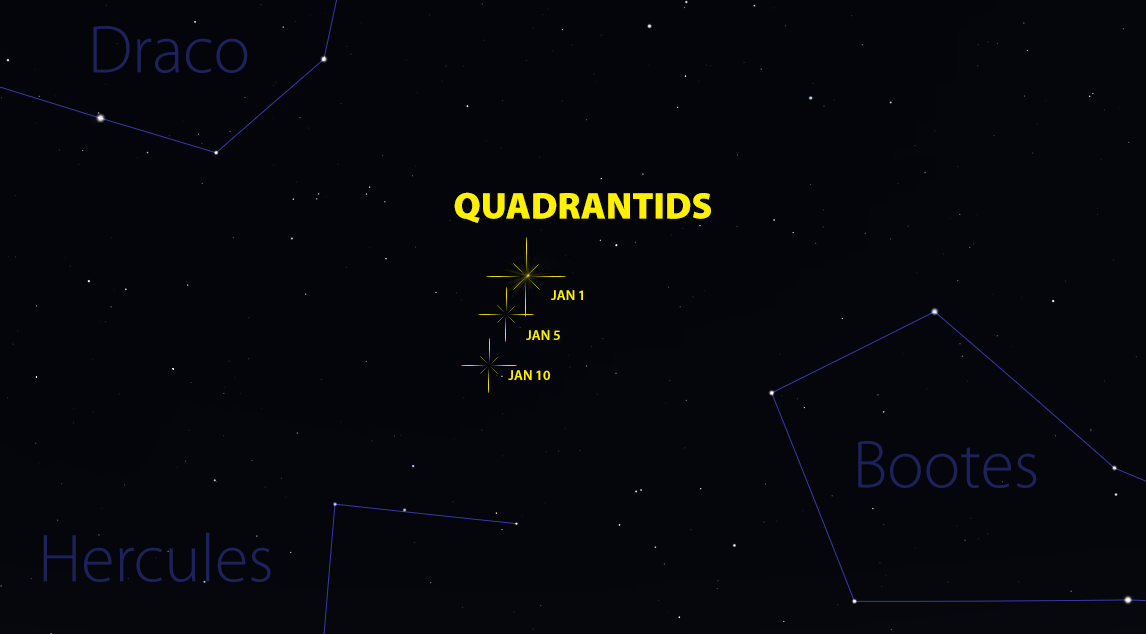
With the waxing crescent moon limited to the early evening skies, conditions will be nearly perfect for viewing the 2017 Quadrantid meteor shower. The peak is expected to occur near 14:00 Universal Time on the morning of January 3rd. This time favors the west coast of the continental United States, the west coast of Canada, and Alaska. 14:00 U.T. is equivalent to 6:00am Pacific Standard Time. This timing is too late for observers in the other three time zones of North America as the sun will either have risen or dawn will have arrived, obscuring any meteor activity. Even though observers located in the eastern ¾ of North America may miss the actual peak, rates of 25 to 50 per hour could still be observed under favorable weather conditions.
The radiant for the Quadrantids lies in a sparse area of northern Bootes. The nearest bright star is second magnitude Alkaid (eta Ursae Majoris), which is the end star in the handle of the “Big Dipper”. This area of the sky lies lowest in the sky near 2000 (8pm) local standard time. As the night progresses the radiant will swing higher into the northeastern sky and is best seen just before dawn.

The Quadrantids are active from December 28-January 10, but little activity is seen away from the morning of the 3rd. Due to the sharp peak of the Quadrantids, rates can also be quite poor as little as 6 hours on either side of the peak timing. This shower has the capability of producing the highest rates of the year for a brief few hours. To see such a display from this shower one must view under dark, transparent skies, with the radiant located high in the sky. In 20 odd opportunities to view this display, I have seen visual hourly rates surpass 100 once. All others were less than 50 and most of them were near 25 per hour at best. Weather is a major factor in viewing the Quadrantids. Cloudiness is often a problem and the cold temperatures can also be brutal on early January mornings. My advice is to bundle up and be comfortable or you will have trouble concentrating on observing.
The Quadrantid meteors are brighter than most with an occasional fireball. With an entry velocity of 42 km/sec., these meteors are of medium velocity. Persistent trains can be seen on the brightest meteors but at a lesser rate than meteors from faster showers such as the Perseids. Since Quadrantid meteors can be seen in any portion of the sky, face toward the darkest direction that is free of trees or other objects that may block your view of the sky. Don’t look straight up; rather look halfway up to see the most activity. Quadrantid meteors entering your field of view will all be parallel with similar velocities. They will all trace backward to the radiant in northern Bootes. Meteors from other sources will enter your field of view from different directions and will have varying velocities. On the morning of January 3rd, a great majority of the meteors seen will be Quadrantids. Meteors from other sources should total less than 10 per hour.
This is your last opportunity to view a major meteor shower until April when the Lyrids become active. So if your skies are clear on the morning of January 3rd, take advantage of viewing this shower!
 American Meteor Society
American Meteor Society
I’m on the west coast of the USA, and I’d like to go out for the Quadrantid peak.
But your date confuses me.
In 2016 the Quadrantid peak was 13:00UT of the 4th, not 3rd, which comes to morning of 4th here on the west coast. And in the Next Major Peak box at the botton of this web-page, it says night of Jan3-4, aka morning of 4th.
So, please, is it morning of 3rd, or morning of 4th? Do I have a misunderstanding?
Isn’t there supposed to be a meteor shower in February? Which one is it and when are the dates? Thanks!
Janine and All,
There are no major meteor showers visible in February. The next one (Lyrids) peak on the night of April 21/22.
Robert Lunsford
I live in the NW part of Costa Rica and cannot seem to find info on viewing area for the Quadrantids. Seldom do you find a site that gives you worldwide info on viewing. Can you help me?
January 13, 2017. I live in Panama City Florida. I was just sitting outside about 10:45 P.M. And the biggest brightest white meteor just skimmed over my back yard over the trees. I have never seen anything like this before. I have seen falling stars. But never anything the size and brightness of this one. I am totally awestruck.